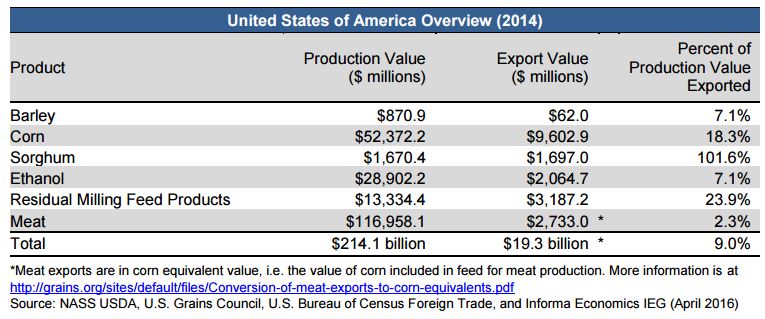



Economic Contribution of Export Trade of US Grain
US - Exports of grain and grain products generated $74.7 billion in annual economic output and added $82 billion in value to the United States’ economy in 2014, according to an Informa Economics IEG study commissioned by the US Grains Council.The US Grains Council (USGC) launched this week an interactive online map showing the value of US grain exports to farmers and the economies of each US state. The new tool is available at www.grains.org/tradevaluemap.
The study offered details of these results by state and selected Congressional districts, showing results for corn, ethanol and its byproduct distiller’s dried grains with solubles (DDGS), corn gluten feed and the corn equivalent of meats, in addition to sorghum and barley.
In 2014, US grain and grain product exports were valued at $19.3 billion – 9.0 per cent of the nation’s grain and grain products production value.
The economic “ripple effects” of these grain and grain products exports created:
- $80 billion in economic output,
- $33 billion in gross domestic product (GDP), and
- 371,536 full-time equivalent jobs in the national economy.
For every $1 million in exports of barley, sorghum, corn, ethanol, DDGS, corn gluten feed and the corn equivalent of meat exports, 19.2 jobs and $1.7 million of GDP are added within the United States.

This study investigated the economic contribution from the export of barley, sorghum, corn, ethanol and its coproducts including distiller’s dried grains with solubles (DDGS) and corn gluten feed (described as “residual milling feed products” in the table below), as well as corn equivalents of meat exports.
Export markets are one outlet for US grain production, and they impact the entire farming value chain. Access to export markets supports jobs and economic activity in sectors including construction and maintenance, restaurants, hospitals, and retail stores, in addition to the transportation apparatus and industry that is in place to handle the outflows of grain products.
Economic Impacts
Every $1 in exports of grains and grain products generates an additional $3.23 in business sales across the US, the study found. The positive economic effects of corn exports benefit not only agriculture, but also wholesale trade, real estate, oil and natural gas production, and the banking and financial industries.
“Farming is a global business, and this study shows how immense the impact of grain exports is on not just the agriculture economy, but our national economy,” said Alan Tiemann, USGC chairman and a farmer in Nebraska. “The work our industry does to build new markets and grow our relationships with those overseas who rely on US grains is critical for US farmers’ profitability.”
The study also touched on the negative consequences to reducing exports of grain products, showing that if these exports were suddenly halted, more than 47,000 jobs and $2.8 billion in GDP would be lost in the farming, ethanol production and meat production industries alone.
Bowling said this study underscores the need for the Trans-Pacific Partnership, the pending trade agreement with 11 other countries that will expand farmers’ market access to the Asia-Pacific region.
“America’s farmers and ranchers have a lot to gain from new trade agreements such as TPP, but there is also a consequence for not moving forward,” Bowling said. “Every day we delay TPP means lost markets, which this study demonstrates has a ripple effect throughout the farm economy. ”




